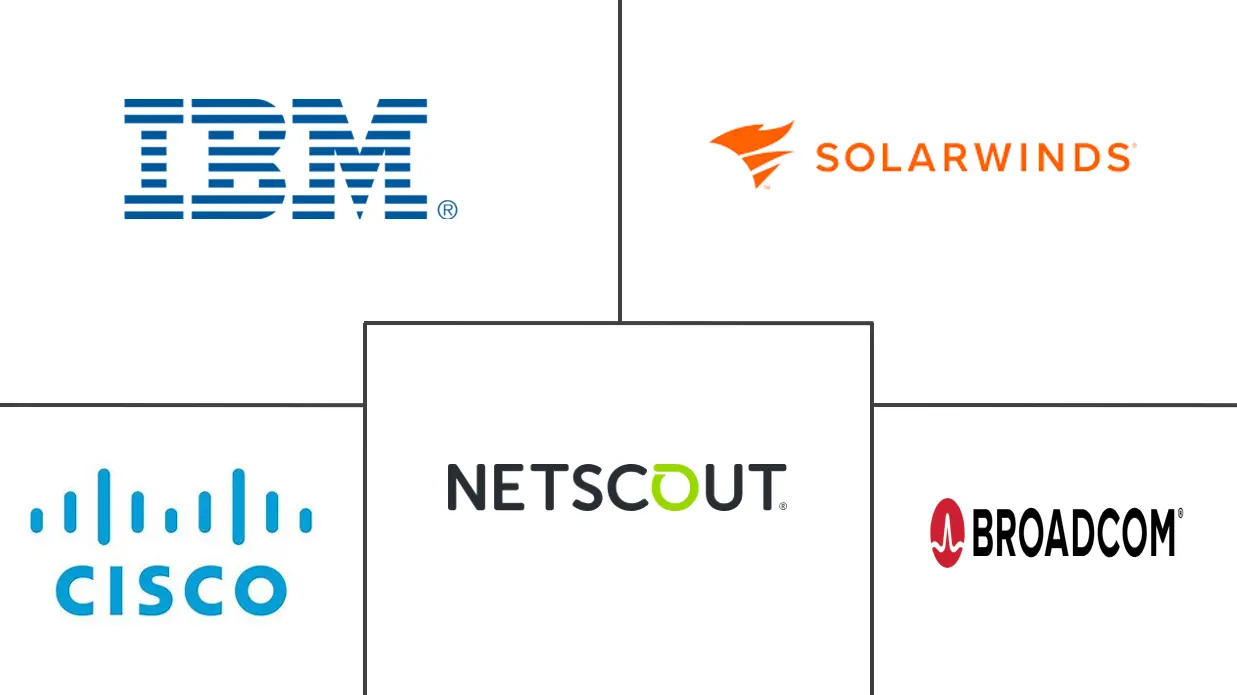Network Monitoring Market Size and Share
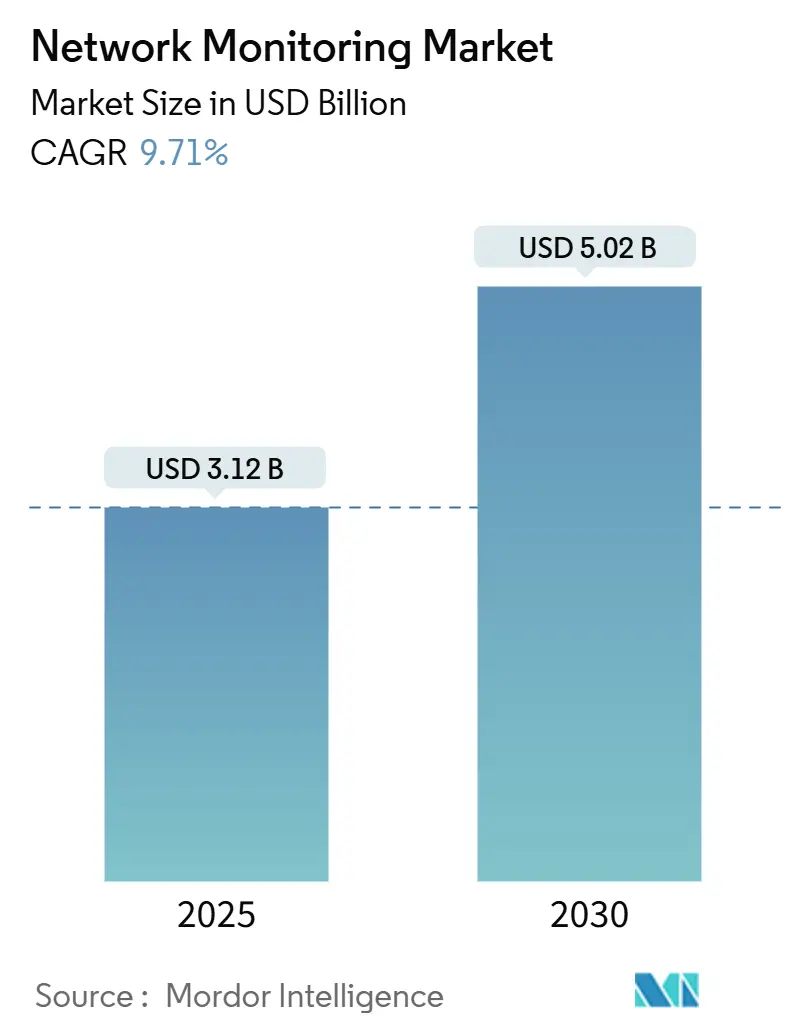
Network Monitoring Market Analysis by Mordor Intelligence
The network monitoring market size stood at USD 3.12 billion in 2025 and is forecast to reach USD 5.02 billion by 2030, registering a 9.71% CAGR across the period. Current expansion reflects a decisive move away from reactive tools toward predictive, AI-enabled observability that handles hybrid cloud complexity and zero-trust security mandates. Rapid 5G rollouts, the rise of distributed workforces, and executive regulations such as Executive Order 14144 are prompting enterprises to modernize visibility stacks. At the same time, data-sovereignty laws in the European Union and Asia-Pacific encourage flexible deployment models that balance on-premise control with cloud analytics. Competitive momentum is shaped by high-profile acquisitions, most notably Cisco’s USD 28 billion purchase of Splunk, which blends security analytics with infrastructure telemetry. Parallel innovation in eBPF packet inspection, AIOps, and edge-aware probes creates opportunities for vendors able to deliver low-latency insights without large capital outlays.
Key Report Takeaways
- By component, Monitoring Equipment captured 55.6% of network monitoring market share in 2024, while Services is projected to expand at an 11.5% CAGR through 2030.
- By deployment mode, On-premise solutions held 62.4% share of the network monitoring market size in 2024; cloud deployment is forecast to advance at 12.4% CAGR to 2030.
- By end-user enterprise size, Large enterprises accounted for 69.5% of revenue in 2024, whereas small and medium-sized enterprises are growing at an 11.9% CAGR.
- By end-user industry, IT and Telecommunications led with 31.7% share in 2024; Healthcare is set to climb at a 12.8% CAGR through 2030.
- By geography, North America commanded 34.7% share in 2024; Asia-Pacific is the fastest-growing region at 11.4% CAGR.
Global Network Monitoring Market Trends and Insights
Drivers Impact Analysis
| Driver | (~) % Impact on CAGR Forecast | Geographic Relevance | Impact Timeline |
|---|---|---|---|
| Proliferation of cloud and hybrid-work traffic | +2.1% | North America and European Union | Medium term (2-4 years) |
| Rapid 5G and IoT traffic expansion | +1.8% | Asia-Pacific core, spill-over to North America and EU | Long term (≥4 years) |
| Cyber-security and zero-trust compliance | +2.3% | North America and European Union, expanding to Asia-Pacific | Short term (≤2 years) |
| AIOps-enabled observability adoption | +1.9% | Global, led by North America | Medium term (2-4 years) |
| Energy-efficient green IT monitoring demand | +0.8% | European Union and North America, emerging in Asia-Pacific | Long term (≥4 years) |
| eBPF-based deep visibility momentum | +1.2% | Global, concentrated in tech-forward enterprises | Medium term (2-4 years) |
| Source: Mordor Intelligence | |||
Proliferation of Cloud and Hybrid-Work Traffic
Enterprises continue to decentralize workloads across multiple clouds and edge locations, which fragments visibility and complicates root-cause analysis. Traditional perimeter tools fail to observe east-west data flows that surge when remote employees access SaaS workloads. Demand therefore rises for unified platforms that correlate performance and security metrics from on-premise fabric, public cloud, and edge nodes. Vendors that offer cloud-native collectors, traffic heat maps, and policy visualization benefit from this sustained shift.
Rapid 5G and IoT Traffic Expansion
Global 5G subscriptions are on track to reach 5.6 billion by 2029, equal to 60% of all mobile lines [1]Ericsson Mobility Report Team, “Ericsson Mobility Report June 2024,” Ericsson, ericsson.com. In Asia-Pacific, India alone could rise from 119 million 5G users in 2023 to 840 million by 2029, while monthly data per smartphone may climb from 29GB to 68GB. Microsecond-level slicing, MEC workloads, and IoT sensor bursts exceed the sampling resolution of legacy probes, so operators adopt eBPF-ready collectors that inspect packets in-kernel and stream metadata to centralized lakes for AI correlation. Predictive algorithms forecast congestion and trigger autonomous scaling to maintain SLA compliance.
Cyber-Security and Zero-Trust Compliance Mandates
Executive Order 14144 requires every US federal agency to implement zero-trust architecture that verifies every session and supports phishing-resistant keys. North American utilities face parallel pressure from NERC CIP-015-1, which mandates real-time internal network security monitoring. European entities prepare for the Digital Operational Resilience Act (DORA) coming into force in January 2025. These overlapping rules elevate logging fidelity, device discovery, and automated incident reporting. Vendors that embed policy mapping, micro-segmentation telemetry, and compliance dashboards gain an edge among risk-averse buyers.
AIOps-Enabled Observability Adoption
Enterprises now expect correlation engines that learn baselines, detect anomalies, and launch self-healing workflows that slash mean time to repair. Vendors integrate large language models that translate natural-language queries into root-cause graphs or produce remediation scripts, lowering skills barriers. Automated prediction of circuit failure and patch conflicts has moved from pilot to production use, tightening the link between observability and business outcomes.
Restraints Impact Analysis
| Restraint | (~) % Impact on CAGR Forecast | Geographic Relevance | Impact Timeline |
|---|---|---|---|
| High-speed appliance capex burden | -1.4% | Global, particularly affecting SMEs | Short term (≤2 years) |
| Skills shortage in NetOps and SecOps | -1.1% | North America and EU, emerging in Asia-Pacific | Medium term (2-4 years) |
| Bundled NEM gear cannibalising stand-alone tools | -0.9% | Global, enterprise segment | Medium term (2-4 years) |
| Data-sovereignty limits on cloud monitoring | -0.8% | Asia-Pacific and EU, selective impact in North America | Long term (≥4 years) |
| Source: Mordor Intelligence | |||
High-Speed Appliance Capex Burden
Migration to 100 Gbps and 400 Gbps links demands appliances that capture packets without loss, yet prices for ASIC-based probes remain high. Capital budgeting becomes acute for small and mid-sized firms that must support AI traffic yet cannot defer refresh cycles. Software-only probes reduce entry costs but may struggle with nanosecond jitter analysis. Vendors respond with consumption pricing, but the trade-off between fidelity and affordability will persist until merchant silicon brings costs down.
Skills Shortage in NetOps and SecOps
Modern toolsets require competency in data science, automation, and zero-trust design. Industry bodies report that one in three enterprises cannot fill observability vacancies within six months, forcing reliance on managed services. As a result, the services category, already on an 11.5% CAGR, gains more traction, but in-house innovation slows and feature adoption lags in understaffed teams.
Segment Analysis
By Component – Services Accelerate Amid Skills Shortages
Monitoring Equipment remained the largest slice of the network monitoring market, generating 55.6% revenue in 2024. The segment continues to serve high-speed packet inspection and branch aggregation, yet shipment volume moderates as enterprises favor software collectors and programmable switches that embed sampling logic. Services, by contrast, will post an 11.5% CAGR as providers wrap AI-driven analytics, 24×7 staffing, and compliance reporting into subscription packages. Managed offerings remove capital hurdles and help resource-constrained teams satisfy zero-trust mandates.
The network monitoring market size for services is projected to widen rapidly as multi-cloud adoption spreads and observability complexity climbs. Integrators that couple on-site rollout with AI tuning capture premium margins, while hardware-centric vendors launch success-based services to retain relevance. The network monitoring market supports a continuum where equipment telemetry, platform software, and managed expertise converge into outcome-based contracts. This model will sustain double-digit growth as buyers seek predictable spend and guaranteed uptime.
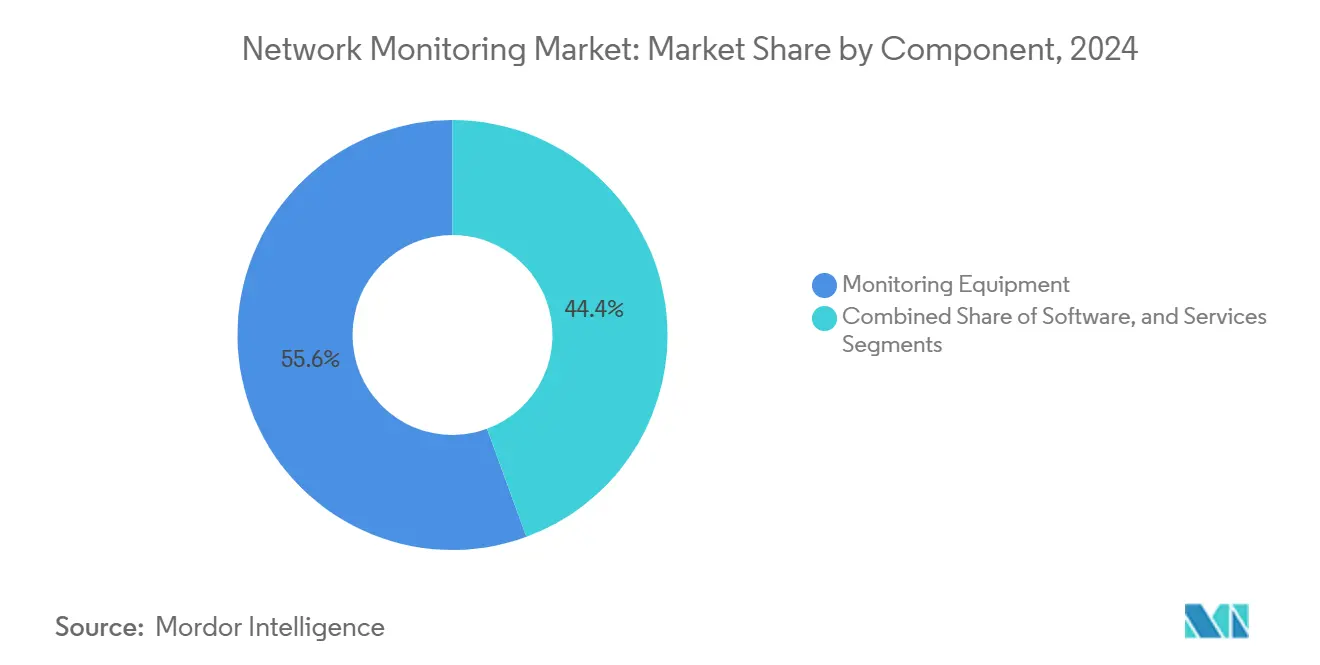
Note: Segment shares of all individual segments available upon report purchase
By Deployment Mode – Cloud Gains Despite Sovereignty Concerns
On-premise deployments held 62.4% of revenue in 2024 because financial services, defence, and critical infrastructure owners keep sensitive packets local for policy reasons. However, public-cloud collectors and SaaS dashboards recorded the fastest rise, advancing at a 12.4% CAGR. The network monitoring market now rewards vendors that support containerized collectors deployable on Kubernetes clusters, bare-metal appliances, or regional sovereign clouds without code changes. The network monitoring market size for cloud deployments will expand as economies of scale make inline analytics affordable for mid-tier firms.
Data-sovereignty rules such as China’s Network Data Security Management Regulations compel hybrid designs that forward meta-data to regional shards, then synthesize insights centrally. Buyers therefore select tools with granular data-handling policies, role-based access control, and portable encryption keys that transfer across tenancy boundaries. Clear migration paths between self-hosted and hosted editions reduce lock-in and become a top criterion on RFP scorecards.
By End-user Enterprise Size – SMEs Embrace Cloud-Native Solutions
Large enterprises represented 69.5% of 2024 spending because they maintain complex WANs, private clouds, and multi-region data centres that demand deep visibility. They deploy layered stacks that span packet capture, flow analysis, and synthetic testing, often federating data into SIEMs for threat hunting. Conversely, SMEs invest in cloud-native suites that auto-discover assets and surface traffic baselines with minimal tuning. This segment will grow at an 11.9% CAGR as SaaS pricing removes hardware barriers and allows pay-as-you-use elasticity.
The network monitoring market provides starter tiers that package core dashboards, anomaly alerts, and compliance templates tailored to vertical regulations. Community marketplaces and auto-generated runbooks compensate for skills gaps, letting small IT teams remediate issues that once required specialist contractors. Over time, SMEs will adopt AI models fine-tuned on anonymized fleet data, improving accuracy while preserving privacy.
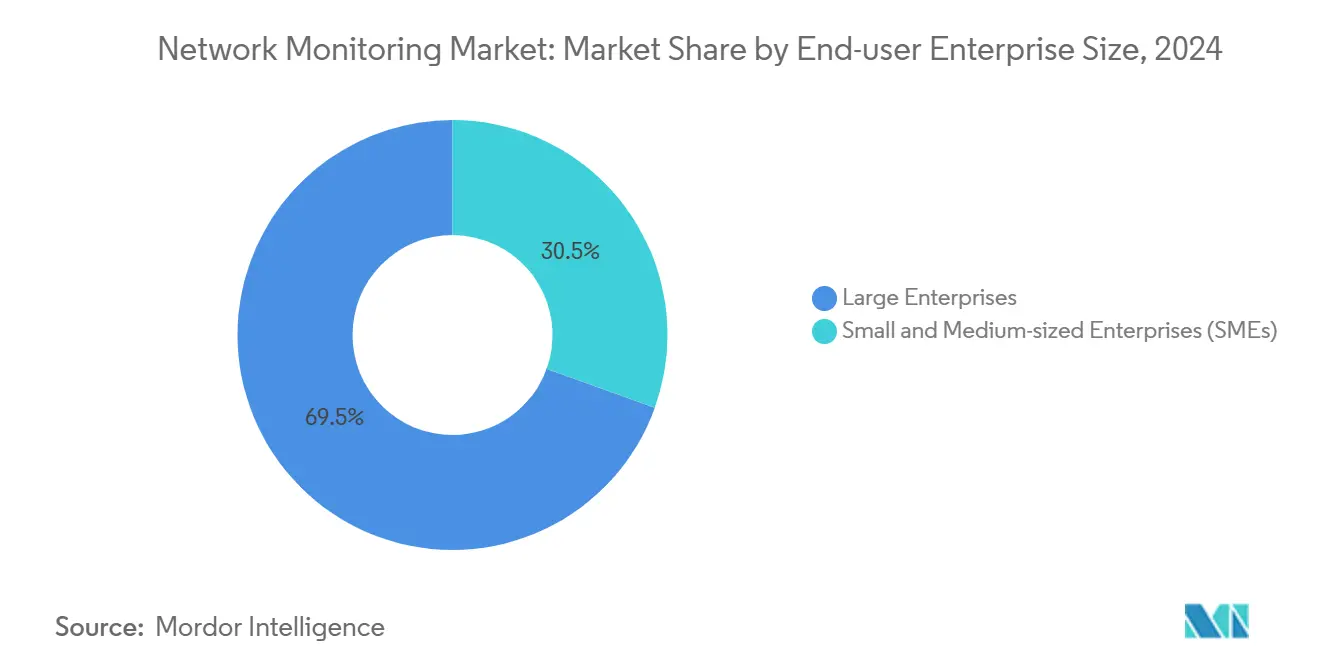
By End-User Industry – Healthcare Leads Digital Transformation
The IT and Telecommunications sector dominated with 31.7% share in 2024. Carriers deploy 5G core slices and MEC endpoints that push telemetry volume above petabyte scale, compelling continuous optimization. Financial institutions adopt deep-packet encryption inspection to counter fraud and meet DORA rules, while energy utilities implement NERC CIP-015-1 internal monitoring for substation control networks. Healthcare, however, is the fastest climber at a 12.8% CAGR. Hospitals move to virtual care, electronic health records, and connected diagnostics that all demand millisecond latency and uncompromised security.
The network monitoring market share of healthcare will therefore enlarge as hospital groups retrofit their networks with micro-segmentation, ransomware detection, and medical-device protocol analytics. Vendors that certify to HIPAA and IEC 80001 standards and integrate with clinical workflow engines gain first-mover advantage. Across verticals, organisations prefer blueprints that combine industry-specific compliance, automated evidence collection, and out-of-box dashboards tuned to operational KPIs.
Geography Analysis
North America retained leadership with 34.7% of 2024 revenue. Investment was propelled by early adoption of AIOps, high 400 Gbps spine-leaf refreshes, and federal zero-trust directives. Buyers in the United States emphasise integration breadth, asking vendors to ingest logs from routers, firewalls, and SaaS APIs in a single data pipeline. Canadian firms focus on latency monitoring for edge AI training that runs in hydro-powered data centres. Throughout the region, cloud marketplaces accelerate procurement cycles, compressing proof-of-concept times from months to weeks.
Europe follows with steady growth supported by large enterprise IT modernisation and strict regulatory frameworks. Digital Operational Resilience Act requirements mandate continuous monitoring, incident reporting within hours, and operational testing of critical ICT services, stimulating demand for platform consolidation. Energy-efficient data centre mandates also inspire adoption of power-aware telemetry that correlates utilisation with carbon goals. Vendors succeed by offering sovereign-cloud options hosted in EU regions and by obtaining ISO 27001 and ENS certifications that resonate with public-sector buyers.
Asia-Pacific delivers the fastest trajectory, registering an 11.4% CAGR to 2030. According to the GSMA, mobile technologies already contribute USD 880 billion to regional GDP and support 13 million jobs. Massive 5G base-station rollouts, government smart-city programs, and local content regulations spur demand for in-country monitoring clusters. India’s surging 5G user base and the proliferation of fintech apps require granular traffic shaping and low-latency analytics. Meanwhile, Japan and South Korea pilot 6G research networks, placing early orders for terabit-ready probes and AI-assisted spectrum analytics. The network monitoring market continues to fragment into language-localised interfaces and regional compliance templates that acknowledge diverse legal regimes.
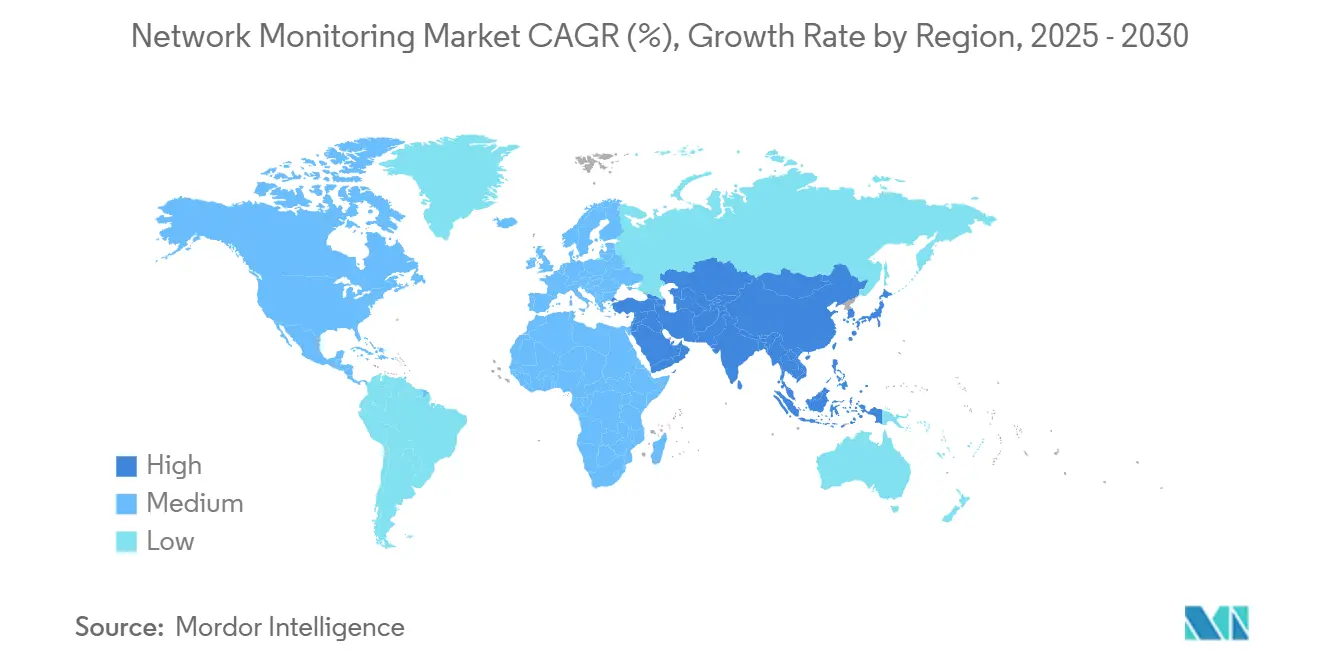
Competitive Landscape
Market concentration is moderate but rising as large vendors acquire analytics specialists. Cisco finalised its USD 28 billion purchase of Splunk in March 2024, creating a portfolio that spans packet sensors, application performance, and SIEM in one licence[2]Cisco Investor Relations, “Cisco Closes Splunk Acquisition,” cisco.com. Datadog advanced its unified vision with the 2025 acquisition of Metaplane, extending coverage from infrastructure–up to data pipelines. These deals address customer fatigue over tool sprawl and satisfy board-level mandates for integrated risk visibility. Legacy hardware makers now embed deep-learning ASICs to process flows on the switch, while cloud-native players add physical taps to accommodate branch offices.
The mid-tier features vendors such as ScienceLogic, whose Skylar AI automates root-cause correlation across dynamic infrastructure, and Kentik, which leverages eBPF sensors for distributed flow tagging. IBM and Juniper outlined a joint generative-AI roadmap that automates guest Wi-Fi management across 44 IBM campuses, signalling wider application of conversational AI to everyday network tasks [3] IBM Newsroom, “IBM and Juniper to Deliver Generative-AI Network Management,” ibm.com. In parallel, Rohde & Schwarz launched the LCM probe for private cellular networks, aiming to capture industrial IoT deployments that exceed Wi-Fi design limits.
Emerging niches include real-time energy monitoring of switch fabrics and privacy-preserving anomaly detection that works on encrypted traffic metadata. Start-ups leverage Rust-based collectors for memory safety and extend detection into operational technology segments. Buyers increasingly evaluate vendors on API openness, data-lake compatibility, and the maturity of pre-trained AI models that shorten tuning cycles. As acquisition pipelines remain active and telcos push platform consolidation, the network monitoring market is expected to see further realignment through 2026.
Network Monitoring Industry Leaders
-
Cisco Systems, Inc.
-
SolarWinds Worldwide, LLC
-
Broadcom Inc.
-
NETSCOUT Systems, Inc.
-
IBM Corporation
- *Disclaimer: Major Players sorted in no particular order
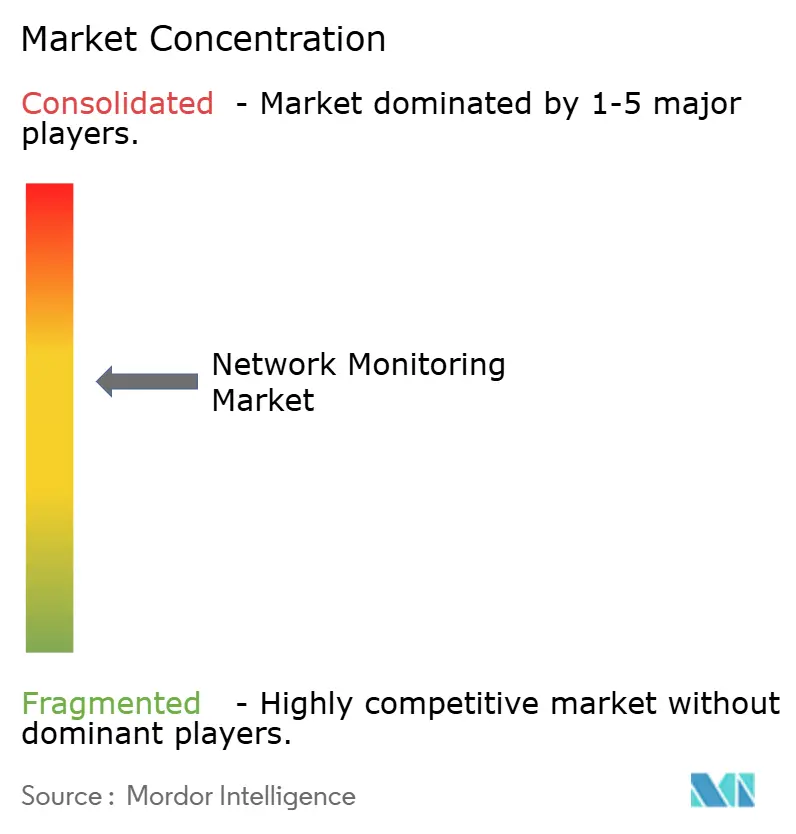
Recent Industry Developments
- June 2025: Vodafone and Cyient introduced an AI-powered global network configuration management platform that provides intelligent analytics across Vodafone’s operations.
- April 2025: Datadog completed its takeover of Metaplane, adding AI-driven data observability to its full-stack monitoring cloud.
- February 2025: IBM and Juniper Networks partnered to build generative-AI-based enterprise network management solutions, integrating Mist AI with IBM watsonx across 44 campuses.
- December 2024: Rohde & Schwarz expanded its private-network test suite with the R&S LCM probe, offering live performance insights for critical networks.
Research Methodology Framework and Report Scope
Market Definitions and Key Coverage
Our study defines the global network monitoring market as revenue from purpose-built appliances, software probes, and cloud services that continuously capture, analyze, and visualize live traffic or performance metrics so administrators can anticipate outages in on-premise, edge, and public-cloud domains. We include initial licenses, hardware sales, and recurring subscriptions that deliver real-time visibility, alerting, reporting, and analytics.
Scope exclusion: pure security detection tools (IDS or NDR) and broad IT service suites lacking packet or flow level monitoring are outside scope.
Segmentation Overview
- By Component
- Monitoring Equipment
- Software
- Services
- Professional Services
- Managed Services
- By Deployment Mode
- On-premise
- Cloud
- Hybrid
- By End-user Enterprise Size
- Large Enterprises
- Small and Medium-sized Enterprises (SMEs)
- By End-User Industry
- IT and Telecommunications
- BFSI
- Healthcare
- Energy and Utilities
- Government
- Retail and E-Commerce
- Industrial and Manufacturing
- Other End-users
- By Geography
- North America
- United States
- Canada
- Mexico
- South America
- Brazil
- Argentina
- Rest of South America
- Europe
- Germany
- United Kingdom
- France
- Italy
- Spain
- Russia
- Rest of Europe
- Asia-Pacific
- China
- Japan
- India
- South Korea
- Australia and New Zealand
- Rest of Asia-Pacific
- Middle East and Africa
- Middle East
- Saudi Arabia
- United Arab Emirates
- Turkey
- Rest of Middle East
- Africa
- South Africa
- Nigeria
- Egypt
- Rest of Africa
- Middle East
- North America
Detailed Research Methodology and Data Validation
Primary Research
Mordor analysts interview network architects at multinational enterprises, procurement leads in telecom carriers, managed service providers across Asia and Europe, and product managers at monitoring vendors. These conversations validate traffic growth, deployment ratios, and licensing models that public documents only hint at.
Desk Research
We begin with open datasets such as FCC traffic filings, Eurostat ICT surveys, APNIC routing statistics, IEEE observability journals, and customs records tracking 10-100 Gbps test gear imports. Our team then parses 10-Ks, S-1s, and investor decks to benchmark average selling prices and renewal mixes, while Dow Jones Factiva news feeds and D&B Hoovers financial snapshots sharpen trend checks. These sources are illustrative; many additional repositories are consulted before any figure is fixed.
Second, we align definitions across regions by reviewing telecom regulator consultations and trade association white papers, which helps us avoid double counting and spot emerging drivers.
Market-Sizing & Forecasting
We build a top-down model that scales the installed base of Ethernet switch ports and cloud instances, applies weighted monitoring penetration by bandwidth tier, and then multiplies by blended ASPs shared during interviews. Sampled supplier roll-ups serve as bottom-up sense checks. Key variables like global IP traffic, hybrid cloud workload share, shipments of 25 Gbps plus ports, NetOps staffing ratios, and renewal cycles feed a multivariate regression, while scenario analysis cushions macro or technology shocks.
Data Validation & Update Cycle
Outputs pass variance tests against historic vendor revenue, peer review every worksheet, and prompt re-contacts when anomalies appear. Reports refresh each year; interim updates follow material events, so clients receive the latest validated baseline.
Why Mordor's Network Monitoring Baseline Earns Decision-Maker Trust
Published figures often differ because providers blend dissimilar product sets, pick divergent traffic thresholds, convert currencies on different dates, and refresh at uneven intervals.
By focusing only on real-time performance tools and anchoring adoption to observed port counts, Mordor Intelligence offers a consistent, decision-ready reference.
Benchmark comparison
| Market Size | Anonymized source | Primary gap driver |
|---|---|---|
| USD 3.12 B (2025) | Mordor Intelligence | |
| USD 3.71 B (2024) | Global Consultancy A | Mixes security analytics and log management with performance monitoring |
| USD 2.40 B (2025) | Research Publisher B | Counts hardware probes only and omits SaaS plus services revenue |
| USD 9.03 B (2023) | Trade Journal C | Bundles wider network management suites and uses older baseline without currency normalization |
These contrasts show that once scope and vintage gaps are stripped away, our disciplined variable choice and annual refresh cadence supply the most transparent and reproducible view of the true opportunity.
Key Questions Answered in the Report
What is the current value of the network monitoring market?
The network monitoring market size is USD 3.12 billion in 2025 and is projected to reach USD 5.02 billion by 2030.
Which segment is expanding the fastest?
Services, driven by managed observability offerings, is growing at an 11.5% CAGR through 2030.
How is zero-trust adoption influencing procurement?
Regulations such as Executive Order 14144 and NERC CIP-015-1 force buyers to choose tools with continuous verification, micro-segmentation visibility, and automated compliance reporting.
What role does AIOps play in modern monitoring?
AIOps platforms apply machine learning to detect anomalies, predict failures, and automate remediation, slashing repair times and improving service reliability.
Page last updated on:
